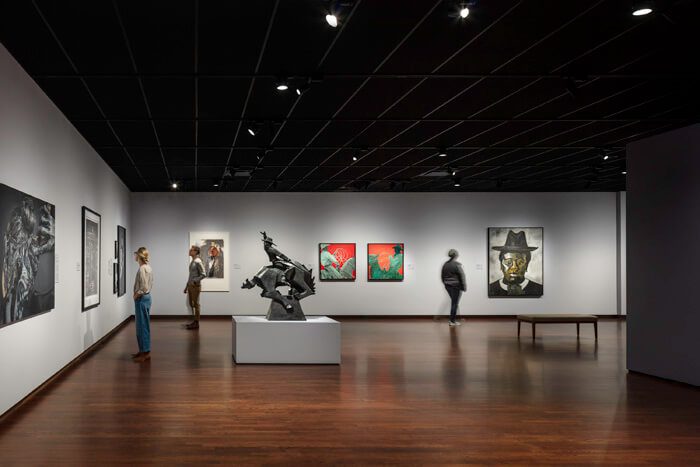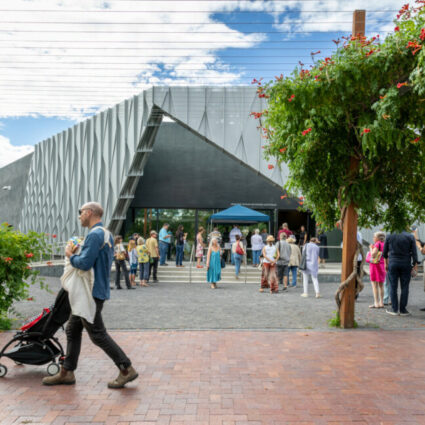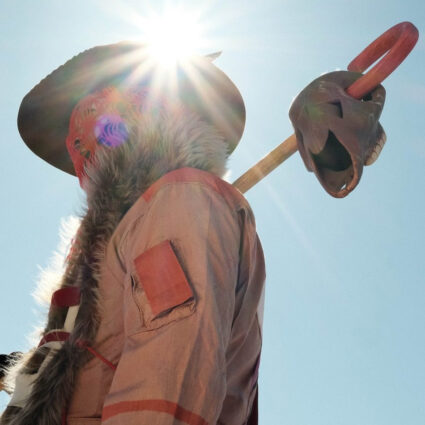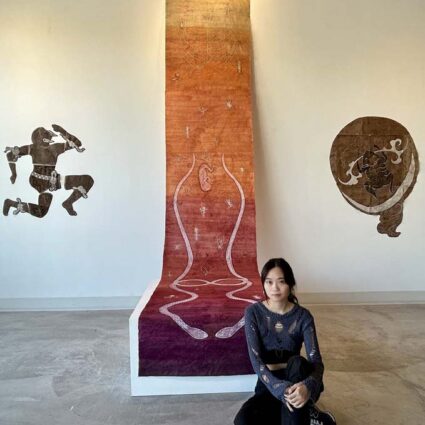After almost four years of construction and renovations, the Martin Building, designed by Gio Ponti and built in 1971, and the Sie Welcome Center are ready to impress Denver Art Museum visitors.
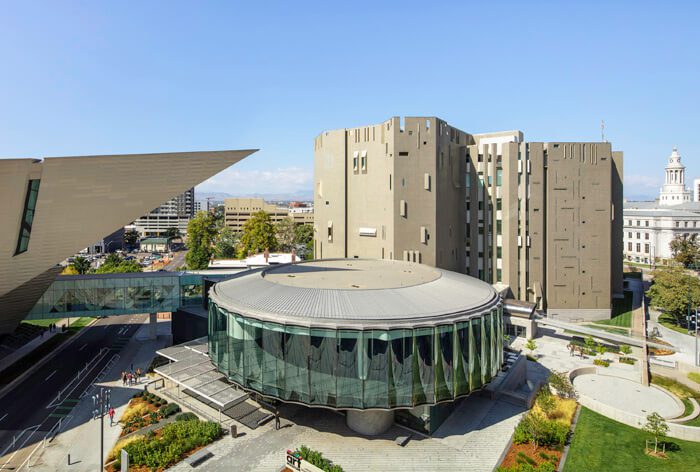
DENVER, CO—When the Daniel Libeskind-designed Hamilton Building opened at the Denver Art Museum in 2006, it stole a bit of thunder from what was then called the North Building, which is architecturally striking in its own right, with its seven stories of gray glass tiles, unusual angles, and slot windows. It’s the only completed building in North America credited to Italian modernist architect Gio Ponti.
But even the most innovative designs can stand some retooling. After almost four years of renovations that involved thinking about the museum grounds more holistically, the North Building—renamed the Martin Building after donors Lanny and Sharon Martin—has reopened to well-deserved fanfare. An October 2021 debut was especially celebratory as it landed on the 50th anniversary of the building’s completion in 1971. The museum calls it a “respectful restoration” of what is essentially the largest object of art in DAM’s collection.
To help connect two architecturally distinct buildings, DAM erected the gleaming Sie Welcome Center, a two-story, 50,000-square-foot elliptical structure with a façade of curved glass panels. It connects the Martin Building to the second floor of the Hamilton Building via a walkway over 13th Avenue in downtown.
Another key aspect of the revisions is how the 210,000-square-foot building has been thematically reorganized, making it easier for visitors to orient themselves and to decide which exhibitions are on their to-do lists. Lively color schemes and elevator graphics guide visitors from one permanent exhibition to the next, as well as to spaces dedicated to changing exhibitions.
Christoph Heinrich, director of the Denver Art Museum, says museums often struggle to entice patrons to make repeat visits and to see an institution beyond its high-profile changing exhibitions. Proving the point for DAM’s Hamilton Building have been the recent blockbuster shows dedicated to Claude Monet and Norman Rockwell, as well as the highly anticipated Whistler to Cassatt: American Painters in France, opening November 14, 2021.
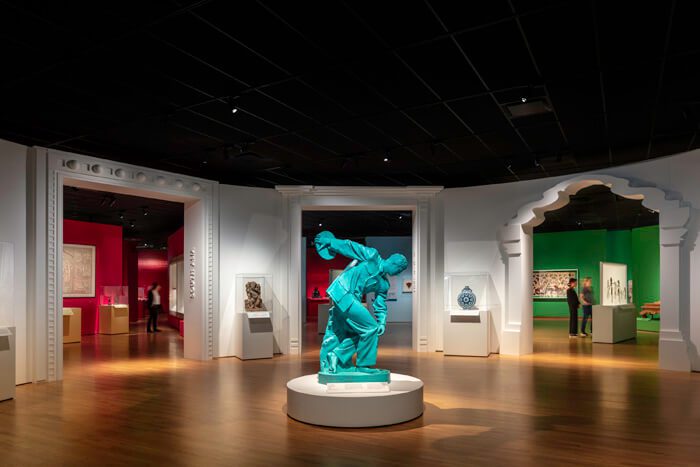
While planning the museum’s new iteration, “We tried to break through that perception by having several spaces spread out over the Martin Building that offer changing exhibitions,” says Heinrich, citing ReVisión: Art in the Americas, an inclusive look at the political, social, and cultural threads that link ancient works with contemporary ones. Taking up a sizable portion of the first floor, ReVisión runs until July 17, 2022. “We want to keep these spaces fresh and to be destinations,” Heinrich adds. “That’s our hope—to lure people over the bridge.”
The floors of the Martin Building and their areas of concentration include Western American Art, seventh floor; European Art Before 1800, Photography, and Textile Art and Fashion, all on the sixth floor; Asian Art, fifth floor; Latin American Art and Art of the Ancient Americas, fourth floor; Indigenous Arts of North America, third floor; and Northwest Coast and Alaska Native Art and Architecture and Design, second floor.
The galleries for Western American art seem especially reinvigorated, with greater emphasis on contemporary artists who capture both the romance of the West and its growing pains. The “Silver Screens and Storytellers” section, for instance, displays videos that call attention to cinematic visions of the West—both what the films got right and what they got wrong.
“It’s not just cowboys chasing Indians. It’s really the idea of the West, of the frontier, and what the West means to us now,” says Heinrich, noting that the top floor seemed especially popular during the building’s opening days.
He adds that he’s pleased with the renewed spotlight on DAM’s collection of the Taos Society of Artists, one of the largest holdings in the country, as well as impressive pieces in Early Modernism and 19th-century bronze sculpture.
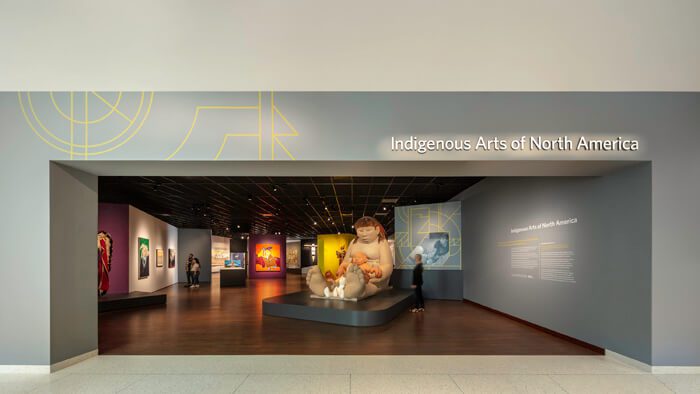
The entry to the Indigenous Arts floor is immediately eye-catching, thanks to the new placement of a monumental Roxanne Swentzell (Santa Clara) sculpture called Mud Woman Rolls On, which she created in situ for a DAM elevator lobby ten years ago. All the galleries purposefully integrate historical and contemporary works that employ a variety of mediums. The priority, though, will always be Indigenous perspectives, Heinrich points out.
“From the beginning of our planning stages, we wanted to make clear we are not showing the history of tribes or the history of Native American life in the Southwest,” he says. “The traditional arts are part of it, of course, but we wanted to start in the here and now.”
The renovations wouldn’t be complete without a few new amenities, including a restaurant called The Ponti and a quick-service café. There’s a playful and brightly colored family space called the Bartlit Learning and Engagement Center, with various hands-on activities. And a particularly thoughtful improvement is the easier access to terraces on the seventh floor, affording a prime view of the mountains of the Front Range.
Another essential stop is the second-level exhibition Gio Ponti: Designer of a Thousand Talents, a space filled with models, drawings, photographs, and biographical information.
With the Martin Building’s $150-million revitalization, the vision for a more tied-together museum campus is complete—the changes bring new energy to the downtown Denver arts and culture hub in the shadow of the State Capitol. Not only has the museum found a way to show off more of its impressive holdings, but it has also created a palpable excitement about the potential—now and in the future—for both buildings.
